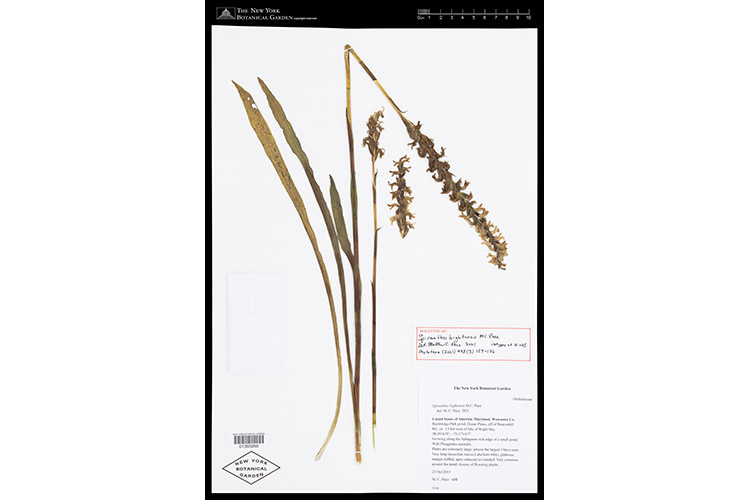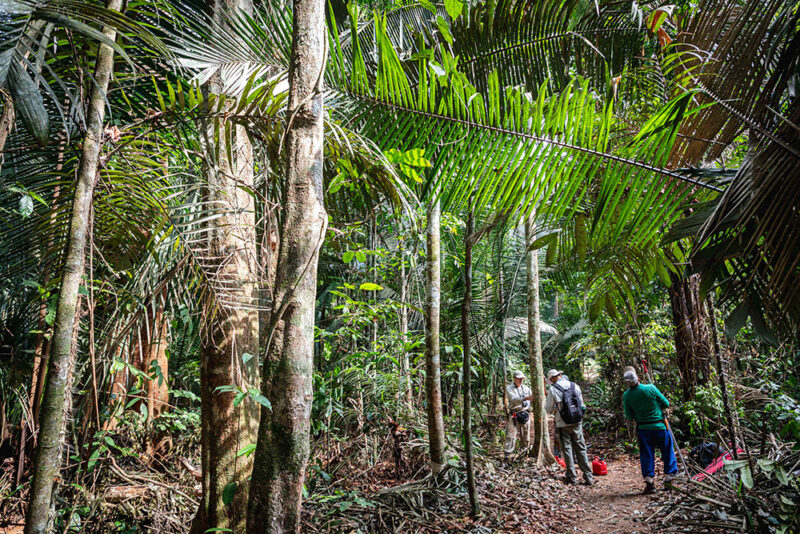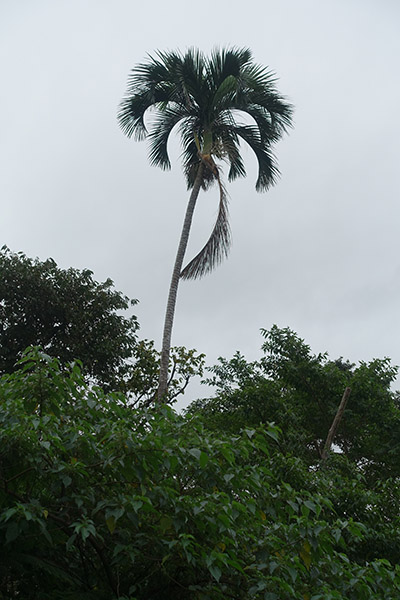Endangered Plants Find New Life in Ebony G. Patterson’s Coming Exhibition
Michaela Wright is the Manager of Interpretive Content at The New York Botanical garden.

An herbarium specimen of Spiranthes bightensis, one of the endangered plants featured in the upcoming exhibition by Ebony G. Patterson
The Earth is in a constant process of turning over from old to new. This summer’s art exhibition of Ebony G. Patterson’s work reminds us that death, decay and loss make way for regeneration and new life. Extinction has always been a part of this natural process. Often, extinction is a complex progression, with many factors that converge to wipe out a species, including natural disasters, changing climates, and natural selection. Today, however, the cycle of natural extinction is off-balance. Over the last several hundred years, once-constant extinction rates have skyrocketed to somewhere between 100 and 1,000 times the baseline. Instead of the familiar factors, recent extinctions have been caused almost exclusively by human impact on the landscape, whether through the introduction of invasive flora and fauna, or through habitat destruction due to agricultural or urban expansion. And that’s just the extinctions we know of—it’s likely we have lost many more plants and fungi that we didn’t even know existed in the first place.
Our current rate of extinction is operating too quickly for the other half of the process, the speciation of new organisms, to keep up. Instead, we are experiencing accelerated loss of biodiversity at a terrifying rate, endangering our ecosystems and ultimately, our place in them.
Each year, the third Friday in May is Endangered Species Day, a time to celebrate, learn about, and take action to protect threatened and endangered species. Ebony G. Patterson’s …things come to thrive…in the shedding…in the molting… gives us a wonderful lens through which to do so. During her yearslong residency with the Garden, Patterson was struck by specimens of extinct plants in the William and Lynda Steere Herbarium. For many of the species on display, they were collected only once or twice, often by amateur scientists before they were lost forever—and before we even knew enough about them to know they were endangered. The herbarium specimens in the Steere Herbarium are some of the only evidence we now have of these once living, thriving species.
In memorial to these lost species, Patterson has created glass sculptures of several extinct plants, and set them into the almost impossibly biodiverse Enid A. Haupt Conservatory. The sculptures’ pale, almost bone-like quality likens them to ghosts or skeletons; standing as a haunting reminder both of what we have lost and what we still stand to lose.

NYBG scientists join local researchers in the Brazilian Amazon to document plant species facing encroaching deforestation.
One of the greatest challenges in protecting threatened and endangered plants from extinction is that, in order to know which species need the most protection, we must have data on the state of the botanical world. Yet, according to a paper by the Proceedings of the National Academy of Sciences (PNAS), there is about 15% of the world’s plant species still to be discovered. That isn’t for lack of trying, at least on NYBG’s part; our scientists have discovered over 1,037 new plants and fungi in the last 25 years, and have targeted over 125,000 plant species for conservation assessment.
The Garden’s mission is to “save the plants of the world”—work that is part of a deep historic legacy initiated by NYBG’s co-founder Elizabeth Britton (1858–1934), a female scientist who founded the Garden with her husband in part to help protect, understand, and classify the native flora of the American Northeast which she so adored. Today, our team of scientists carries on this legacy: Dr. Robert Naczi’s work creating a complete floristic manual of the northeast will aid conservation efforts by providing up-to-date survey data on plants of the Northeast, potentially identifying endangered native plants. Resident lichenologist Dr. James Lendemer is working to survey endangered lichens of the Appalachian Mountains and has nominated dozens of lichen species to the International Union for Conservation of Nature’s Red List, the world authority on endangered and threatened plants.

Carpoxylon macrospermum growing in Vanuatu
Some of our scientists work further afield. Garden scientists Gregory M. Plunkett, Ph.D., and Michael J Balick, Ph.D., are working to document the complete flora of Vanuatu, a chain of 80 islands in the Southern Pacific Ocean. Extinction rates are highest on islands (like Vanuatu), which tend to have more endemic (grows nowhere else) plants with smaller populations and more limited genetic diversity. When these already scarce plants lose habitat to human activity, such as development of new buildings for tourism, they have nowhere else to go. During their work, Vanuatu’s communities sought Dr. Plunkett and Dr. Balick’s help in preserving the plants they noticed were disappearing. From this collaboration, a new model of conservation resulted. The new model is community-directed, in-situ conservation that prioritizes and preserves local plant knowledge and is community-directed and implemented. In collaboration with communities in Vanuatu, Dr. Balick and Dr. Plunkett have also developed a list of at least 30 threatened plants to assess for the IUCN Red List of Endangered species. Without this data, global scientists and policy makers would have no idea that these plants are threatened. Conservation of a critically endangered palm species, Carpoxylon macrospermum, using Dr. Balick and Dr. Plunkett’s community partnership model is already under way and a healthy new generation of the Carpoxylon macrospermum palm is on the horizon.
Patterson’s exhibition sheds light on endangered and extinct species and brings the work of our scientists from around the world to NYBG visitors. Patterson’s extinct plants are an exhortation not only to memorialize loss, but also towards healing. NYBG scientists’ work is an important contribution to that end, but more must be done.
Explore Patterson’s works this summer at the Garden and view the extinct plant specimens that inspired her. To learn more about how the Garden supports conservation of endangered and threatened plants, visit Plant Research & Conservation!
SUBSCRIBE
Enter your email address to subscribe to this blog and receive updates on new posts.











